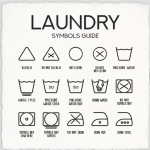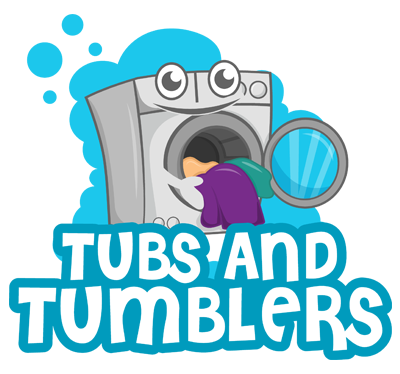
How to Wash Bras to Maintain Their Shape and Support
May 21, 2024
Laundry Symbols Demystified: How to Read Care Labels
July 4, 2024Doing laundry seems like a straightforward task, yet it often leaves us puzzled with numerous questions. From deciphering care labels to combating stubborn stains, the world of laundry can be a perplexing maze. Fear not, for we have compiled a guide to address the most prevalent questions about laundry, equipping you with invaluable knowledge to conquer this seemingly daunting chore.
Sorting Dilemmas: Demystifying the Art of Separating Clothes
Proper sorting is the cornerstone of effective laundering, yet it often sparks confusion. Should you separate whites from colors? How about delicates and heavy-duty fabrics? The answers lie in understanding the nuances of fabric types and dye behavior.
Why Sorting Matters
Sorting clothes is crucial for several reasons:
- It prevents dye transfer from colored garments to whites, preserving their pristine appearance.
- Different fabric types require varying wash cycles and temperatures to maintain their integrity.
- Separating heavy-duty items like towels from delicates like lingerie ensures each garment receives the appropriate level of agitation and care.
Sorting Strategies
To streamline the sorting process, consider the following strategies:
- Establish separate hampers or baskets for whites, lights, darks, and delicates.
- Read care labels carefully and sort accordingly.
- Separate heavily soiled garments from lightly soiled ones to prevent soil transfer.
- Keep a dedicated mesh bag for delicates to protect them during the wash cycle.
By adopting a systematic approach to sorting, you can ensure that each garment receives the care it deserves, prolonging its lifespan and preserving its vibrant colors.
Stain Removal Strategies: Tackling Tough Stains Head-On
Stains are the bane of every laundry enthusiast’s existence, but fear not! With the right techniques and products, even the most stubborn stains can be vanquished.
Fresh vs. Set-in Stains
The approach to stain removal varies depending on the age of the stain:
- Fresh stains are easier to treat as they have not fully set into the fabric fibers.
- Set-in stains require more aggressive treatment and may necessitate multiple attempts for complete removal.
Stain Removal Techniques
Here are some effective techniques for tackling various types of stains:
- Protein-based stains (e.g., blood, sweat, grass): Pretreat with an enzyme-based detergent or stain remover.
- Oil and grease stains: Apply dish soap or a degreasing agent before washing.
- Ink stains: Treat with a solvent-based stain remover or hairspray (for ballpoint ink).
- Red wine stains: Blot with club soda or white vinegar and then pretreat with an enzymatic stain remover.
- Mud and dirt stains: Allow to dry completely before brushing off excess and pretreating with a heavy-duty detergent.
Remember, patience and persistence are key when dealing with stubborn stains. If a stain persists after multiple attempts, consider seeking professional assistance. Tubs and Tumblers can assist you with stubborn stains through our wash and fold service.
Decoding Care Labels: A Guide to Laundry Symbols
Care labels can seem like a cryptic language, but understanding their symbols is crucial for proper garment care. Ignoring these instructions can lead to shrunken sweaters, faded colors, and irreparable damage.
Common Laundry Symbols and Their Meanings

Here are some of the most common laundry symbols and their interpretations:
- Washing symbols (e.g., tub with wavy lines): Indicate the recommended water temperature and wash cycle.
- Bleaching symbols (e.g., triangle): Specify whether chlorine or non-chlorine bleach can be used.
- Drying symbols (e.g., square with a circle inside): Indicate the appropriate drying method (tumble dry, line dry, or flat dry).
- Iron symbols (e.g., iron with dots): Provide guidance on the recommended ironing temperature and whether steaming is allowed.
Interpreting Care Labels Correctly
To ensure proper garment care, follow these tips when reading care labels:
- Familiarize yourself with the symbols and their meanings.
- If unsure, err on the side of caution and choose the gentlest care method.
- For items labeled “Dry Clean Only,” it’s best to follow the instructions to avoid potential damage.
By adhering to care label guidelines, you can extend the lifespan of your garments and maintain their quality and appearance.
Choosing the Right Laundry Detergent
With countless detergent options lining store shelves, selecting the right one can be a daunting task. However, understanding the ingredients and their impact on your clothes and the environment is crucial.
Here’s a breakdown of common detergent ingredients and their roles:
- Surfactants: These cleaning agents help remove dirt and stains from fabrics.
- Enzymes: Enzymes break down specific types of stains, such as protein-based or oil-based stains.
- Optical brighteners: These additives enhance the appearance of whiteness in fabrics by absorbing and reflecting specific wavelengths of light.
- Fragrances: While not essential for cleaning, fragrances provide a pleasant scent to the detergent and freshly laundered clothes.
Choosing an Eco-Friendly Option
For those concerned about the environmental impact of laundry detergents, consider eco-friendly options that are free from harmful chemicals and biodegradable. Look for detergents that are plant-based, free of phosphates, and certified by reputable organizations like the Environmental Working Group (EWG).
High-Efficiency (HE) Detergents
If you own a high-efficiency (HE) washing machine, it’s crucial to use HE-compatible detergents. These formulations are designed to produce fewer suds, preventing excessive buildup and potential machine damage. Using non-HE detergents in an HE machine can lead to residue buildup, inefficient cleaning, and potential repair costs.
By understanding the ingredients and choosing a detergent that aligns with your needs and values, you can ensure effective cleaning while minimizing environmental impact and prolonging the lifespan of your garments.
Fabric Softeners and Dryer Sheets: Necessity or Luxury?
The debate surrounding the use of fabric softeners and dryer sheets is ongoing. While some swear by their softening and static-reducing properties, others question their necessity and potential environmental impact.
Understanding Fabric Softeners and Dryer Sheets
Fabric softeners and dryer sheets work by coating fabric fibers with a lubricating layer, which helps reduce static cling and imparts a soft, fluffy feel to clothes. Many also contain fragrances to provide a fresh scent.
Eco-Friendly Alternatives
If you prefer to avoid traditional fabric softeners and dryer sheets, consider these eco-friendly alternatives:
- Wool dryer balls: These reusable balls help soften clothes and reduce static cling through gentle agitation during the drying cycle.
- Vinegar: Adding a small amount of white vinegar to the rinse cycle can help soften fabrics and reduce static cling.
- Baking soda: A small amount of baking soda in the wash cycle can help soften clothes and remove odors.
By weighing the pros and cons and exploring eco-friendly alternatives, you can make an informed decision about whether fabric softeners and dryer sheets are right for your laundry routine.
Tackling Odor Removal: Fresh Scents for Your Fabrics
Unpleasant odors can cling to fabrics, making them less than appealing to wear or use. Whether it’s sweat, smoke, or musty smells, effective odor removal is a common laundry concern.
Sources of Odor in Fabrics
Fabrics can absorb odors from a variety of sources, including:
- Body odor and perspiration
- Smoke from cigarettes or fires
- Cooking odors
- Mildew or musty smells from damp or poorly ventilated areas
Odor Removal Techniques
Here are some effective techniques for removing odors from fabrics:
- Baking soda: Add a half cup of baking soda to the wash cycle to help absorb and neutralize odors.
- Vinegar: White vinegar is a natural deodorizer and can be added to the rinse cycle or used as a pre-soak for particularly smelly items.
- Enzyme-based detergents: These detergents contain enzymes that help break down and remove odor-causing compounds.
- Borax: A natural mineral compound, borax can help remove odors and whiten fabrics when added to the wash cycle.
- Sunlight: Hanging fabrics in direct sunlight can help neutralize odors and freshen them naturally.
Preventing Odor Buildup
In addition to effective Odor buildup, it’s essential to practice good laundry habits to prevent odors from developing in the first place. Promptly removing sweaty or soiled clothing from hampers, washing items regularly, and ensuring proper ventilation in your laundry area can go a long way in keeping fabrics fresh and odor-free.
Shrinkage Solutions: Reversing the Unwanted Effects
Shrinkage is a common laundry woe that can render beloved garments unwearable or ill-fitting. While prevention is always the best approach, there are techniques you can employ to reverse or minimize the effects of shrinkage.
Causes of Shrinkage
Shrinkage can occur due to several factors, including:
- Exposure to high heat during washing or drying
- Agitation during the wash cycle
- Improper care for specific fabric types (e.g., wool, silk, or linen)
Prevention Strategies
To minimize the risk of shrinkage, consider the following preventive measures:
- Read and follow care labels carefully, adhering to recommended water temperatures and drying methods.
- Wash delicate or shrink-prone fabrics in cold water and air-dry them.
- Use a gentle or delicate cycle for items prone to shrinkage.
- Avoid overloading the washing machine or dryer, as this can contribute to excessive agitation and heat exposure.
Unshrinking Techniques
If shrinkage has already occurred, there are techniques you can try to restore the garment to its original size:
- For cotton or wool items, soak the shrunken garment in a solution of warm water and hair conditioner or baby shampoo. Gently stretch and reshape the item while damp, and then air-dry flat.
- For synthetic fabrics, try soaking the item in a solution of warm water and fabric softener or vinegar, then gently stretching and reshaping it before air-drying.
- For knitted items like sweaters, you can try blocking the garment by pinning it to the desired measurements while damp and allowing it to dry completely before removing the pins.
While unshrinking techniques can be effective in some cases, they may not work for severely shrunken items or those made from delicate fabrics. In such cases, it’s best to consult a professional or consider replacing the garment.
Delicate Care: Handling Fragile Fabrics with Finesse
Delicate fabrics like silk, lace, and chiffon require special care to maintain their beauty and integrity. Improper handling can lead to snags, tears, or irreparable damage, making it essential to understand the specific needs of these fragile materials.
Identifying Delicate Fabrics
Before attempting to launder delicate items, it’s crucial to identify the fabric type correctly. Common delicate fabrics include:
- Silk
- Lace
- Chiffon
- Satin
- Cashmere
- Wool
- Linen
Check the care labels for specific instructions and proceed with caution when handling these delicate materials.
Gentle Washing Techniques
When washing delicate fabrics, follow these gentle techniques:
- Hand-wash or use a delicate cycle on your washing machine with minimal agitation.
- Use cool or lukewarm water and a mild, gentle detergent designed for delicates.
- Avoid using bleach or harsh chemicals, as they can damage the fibers.
- Gently squeeze or roll the garments instead of wringing or twisting them, which can cause distortion or damage.
Drying Delicates
Proper drying is just as important as gentle washing when it comes to preserving delicate fabrics. Consider the following methods:
- Air-drying is the safest option, as it avoids the heat and tumbling action of a dryer.
- If using a dryer, choose the delicate or air-fluff setting and use low heat.
- Lay flat or hang delicate items to dry, avoiding direct sunlight, which can cause fading or damage.
Storing and Caring for Delicates
Proper storage and care can extend the lifespan of your delicate garments:
- Store delicate items in breathable garment bags or boxes to protect them from dust, moisture, and insects.
- Avoid storing delicates in plastic bags, as this can trap moisture and encourage mildew growth.
- Handle delicate items with care, avoiding unnecessary folding or creasing.
- Consider using acid-free tissue paper or fabric rolls when storing delicate items to maintain their shape and prevent creasing.
By understanding the unique needs of delicate fabrics and employing gentle handling techniques, you can ensure that your precious garments maintain their beauty and integrity for years to come.




